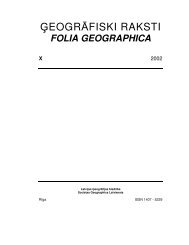eogrÄfiski raksti folia geographica xii - Ä¢eogrÄfijas un Zemes zinÄtņu ...
eogrÄfiski raksti folia geographica xii - Ä¢eogrÄfijas un Zemes zinÄtņu ...
eogrÄfiski raksti folia geographica xii - Ä¢eogrÄfijas un Zemes zinÄtņu ...
Create successful ePaper yourself
Turn your PDF publications into a flip-book with our unique Google optimized e-Paper software.
71<br />
HUMAN GEOGRAPHY<br />
economy has changed greatly. However, the availability of a wide range of jobs and the<br />
development of new and dynamic sectors of the economy create a growing demand for qualified<br />
workers, and this could serve to increase migration flows [Krišjāne, Bauls 2002].<br />
The process of daily commuting in Latvia is now beginning to be <strong>un</strong>derstood. Results of<br />
the research by the Department of human geography, at the University of Latvia on population<br />
mobility in the seven largest urban areas at the end of 90ties allow us to identify several new<br />
trends in this area:<br />
(1) In comparison to the late 1980s and early 1990s, there has been a very significant decline<br />
in the flow of daily commuting from the centres of urban areas to the periphery, because<br />
suburban job opport<strong>un</strong>ities have in many cases disappeared. Major collective farms that<br />
used to be near cities have collapsed, and many of the people who worked in the<br />
kolkhozes – especially scientific specialists – who lived in the cities no longer had jobs,<br />
and thus urban to rural commuting has declined.<br />
(2) The decline in daily commuting within cities has been influenced by the fact that many<br />
Soviet-era industrial factories shut down or reduced their output. A major example was<br />
the closure of the van-producing factory in Jelgava.<br />
(3) The intensity of daily commuting from suburban areas to the centres of cities today<br />
depends on the level of development in cities and on their ability to adapt to the demands<br />
of the market economy. The volume of daily commuting to Ventspils has nearly doubled,<br />
because that city is home to a very successful port.<br />
(4) Job losses in rural areas have led people to go to work in cities and many employees stay<br />
in the cities during the week [Bauls, Krišjāne 2000; Department of human geography<br />
2000].<br />
Figure 1. The Riga Agglomeration and other major urban areas<br />
Additional data about population mobility in the Riga metropolitan area have led to the<br />
conclusion that the process has very much been affected by socio-economic change in Latvia.<br />
There have been more rapid economic transformation processes in Riga and its environs than in<br />
other parts of Latvia. New and dynamic sectors of the economy are emerging, which is<br />
evidenced by the fact that 60% of the co<strong>un</strong>try’s foreign investment has gone to the Riga area<br />
[LR CSP/CSBL 2002]. There has been a rapid increase in the demand for highly qualified<br />
workers and specialists, and the fact that they have been fo<strong>un</strong>d is proven by the increase in the<br />
flow of daily commuting. In 2000 there were 56,000 commuters while in year 2003 the number<br />
had increased to 67,000 [LR CSP/CSBL 2004].

















